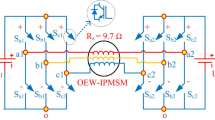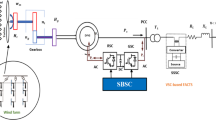Abstract
A methodology for the steady state analysis of self-excited induction generators (SEIGs) is proposed employing an approach using simple co-ordinate geometry. The equivalent circuit of the SEIG is taken and its three complex admittances, Y̅1, Y̅2 and Y̅3, are considered. Using the nodal analysis of the circuit and considering the nature of the parameters involved for ensuring self-excitation of the induction machine, it is shown that a triangle can be obtained by plotting Y̅1, Y̅2 and Y̅3 in the complex plane. Utilizing the well-known properties of the triangle, in a few steps, a simple equation is derived for the per unit (pu) speed, in terms of pu frequency, real part of Y̅1 and rotor resistance. This, consequently, leads to another simple expression for the calculation of the magnetizing reactance and further processing of the performance analysis of SEIG. Thus, this proposed method does not require advanced techniques or complex calculations. The analytical results arrived at are compared with those calculated using the popularly adopted genetic algorithm technique and recently evolved binary search method and also with the values obtained experimentally on a 3-phase, 3.75 kW, 230 V delta-connected induction machine run as an SEIG. A very close agreement is seen between these three sets of results.





Similar content being viewed by others
Availability of data and materials
No datasets were generated or analysed during the current study. However, the machine parameters used for supporting the results and analyses in the article are obtained in the laboratory.
Abbreviations
- a :
-
Per unit (pu) frequency, fg/fr
- b :
-
pu speed, Nr/Ns
- C :
-
Per phase excitation capacitance, F
- E̅ :
-
Per phase air gap voltage, V
- f g :
-
Generated frequency, Hz
- f r :
-
Rated frequency, Hz
- N r :
-
Actual speed of rotor, rpm
- N s :
-
Synchronous speed at rated frequency, rpm
- R/X :
-
Per phase load resistance/reactance, Ω
- R 1/R 2 :
-
Per phase stator/rotor (referred to stator) resistance, Ω
- X 1/X 2 :
-
Per phase stator/rotor (referred to stator) reactance, Ω
- X C :
-
Per phase excitation capacitance reactance, Ω
- X m :
-
Per phase magnetizing reactance, Ω
- X mc :
-
Per phase critical magnetizing reactance, Ω
References
Arasada S (2021) RENEWABLES 2021—Global status report URL: https://www.ren21.net/reports/global-status-report/. Accessed on 22 Jan 2022
Heidari A, Bansal RC (2021) Probabilistic correlation of renewable energies within energy hubs for cooperative games in integrated energy markets. Electr Power Syst Res. https://doi.org/10.1016/j.epsr.2021.107397
Ourahou M, Ayrir W, EL Hassouni B, Haddi A (2020) Review on smart grid control and reliability in presence of renewable energies: challenges and prospects. Math Comput Simul 167:19–31. https://doi.org/10.1016/j.matcom.2018.11.009
Varshney L, Vardhan AS, Vardhan AS, Kumar S, Saket RK, Sanjeevikumar P (2021) Performance characteristics and reliability assessment of self-excited induction generator for wind power generation. IET Renew Power Gener 15:1927–1942. https://doi.org/10.1049/rpg2.12116
Ali SW et al (2021) Offshore wind farm-grid integration: a review on infrastructure, challenges, and grid solutions. IEEE Access 9:102811–102827. https://doi.org/10.1109/ACCESS.2021.3098705
Arthishri K, Kumaresan N, Ammasai Gounden N (2019) Analysis and application of three-phase SEIG with power converters for supplying single-phase grid from wind energy. IEEE Syst J 13(2):1813–1822
Raj RE, Kamalakannan C, Karthigaivel R (2018) Genetic algorithm-based analysis of wind-driven parallel operated self-excited induction generators supplying isolated loads. IET Renew Power Gener 12(4):472–483
Nayanar V, Kumaresan N, Ammasai Gounden N (2016) A single sensor based MPPT controller for wind-driven induction generators supplying DC microgrid. IEEE Trans Power Electron 31(2):1161–1172
Iannuzzi D, Pagano E, Piegari L, Veneri O (2003) Generator operations of asynchronous induction machines connected to ac or dc active/passive electrical networks. Math Comput Simul 63(3–5):449–459. https://doi.org/10.1016/S0378-4754(03)00088-0
Bansal RC (2005) Three-phase self-excited induction generators: an overview. IEEE Trans Energy Convers 20(2):292–299
Kumaresan N, Selvan MP, Subbiah M (2004) Design optimisation and speed extension of wind-driven self-excited induction generators—a new approach. Electr Power Compon Syst 32(2):215–228
Murali Krishna VB, Sandeep V, Murthy SS, Yadlapati K (2022) Experimental investigation on performance comparison of self excited induction generator and permanent magnet synchronous generator for small scale renewable energy applications. Renew Energy 195:431–441
Choudhary R, Saket RK (2015) A critical review on the self-excitation process and steady state analysis of an SEIG driven by wind turbine. Renew Sustain Energy Rev 47:344–353. https://doi.org/10.1016/j.rser.2015.03.043
Karthigaivel R, Kumaresan N, Subbiah M (2011) Analysis and control of self-excited induction generator-converter systems for battery charging applications. IET Electr Power Appl 5(2):247–257
Chauhan YK, Jain SK, Singh B (2010) A prospective on voltage regulation of self-excited induction generators for industry applications. IEEE Trans Ind Appl 46(2):720–730. https://doi.org/10.1109/TIA.2009.2039984
Malik NH, Haque SE (1986) Steady state analysis and performance of an isolated self-excited induction generator. IEEE Trans Energy Convers EC-1(3):134–140. https://doi.org/10.1109/TEC.1986.4765746
Ammasaigounden N, Subbiah M, Krishnamurthy M (1986) Wind driven self-excited pole-changing induction generators. Proc IET B-Electr Power Appl 133(5):315–321
Ouazene L, McPherson G (1983) Analysis of the isolated induction generator. IEEE Trans Power Appar Syst PAS-102(8):2793–2798. https://doi.org/10.1109/TPAS.1983.317962
Malik NH, Haque SE (1986) Steady state analysis and performance of an isolated self-excited induction generator. IEEE Trans Energy Convers EC-1(3):134–140. https://doi.org/10.1109/TEC.1986.4765746
Singh SP, Jain M, Singh B (1995) A new technique for the analysis of self-excited induction generator. Electr Mach Power Syst 23:647–656
Alghuwainem SM (1999) Steady-state analysis of an isolated self-excited induction generator driven by regulated and unregulated turbine. IEEE Trans Energy Convers 14(3):718–723. https://doi.org/10.1109/60.790941
Haque MH (2009) A novel method of evaluating performance characteristics of a self-excited induction generator. IEEE Trans Energy Convers 24(2):358–365. https://doi.org/10.1109/TEC.2009.2016124
Khlifi MA, Ben Slimene M, Ben Fredj M et al (2016) Performance evaluation of self-excited DSIG as a stand-alone distributed energy resource. Electr Eng 98(159–167):2016. https://doi.org/10.1007/s00202-015-0349-y
Alolah AL, Alkanhal MA (2000) Optimization-based steady state analysis of three phase self-excited induction generator. IEEE Trans Energy Convers 15(1):61–65
Kheldoun A, Refoufi L, Khodja DE (2012) Analysis of the self-excited induction generator steady state performance using a new efficient algorithm. Electr Power Syst Res 86:61–67
Arthishri K, Anusha K, Kumaresan N, Kumar SS (2017) Simplified methods for the analysis of self-excited induction generators. IET Electr Power Appl 11(9):1636–1644
Bouhadjra D, Kheldoun A, Zemouche A (2020) Performance analysis of stand-alone six-phase induction generator using heuristic algorithms. Math Comput Simul 167:231–249
Joshi D, Sandhu K, Bansal R (2013) Steady-state analysis of self excited induction generators using genetic algorithm approach under different operating modes. Int J of Sustain Energy 32(4):244–258
Karthigaivel R, Kumaresan N, Raja P, Subbiah M (2009) A novel unified approach for the analysis and design of wind-driven SEIGs using nested GAs. Wind Eng 33(6):631–647
Chauhan YK, Yadav VK, Singh B (2013) Optimum utilisation of self-excited induction generator. IET Electr Power Appl 7(9):680–692
Ibrahim HE, Serag M (2011) Analysis of self excited induction generator using particle swarm optimization. World Acad Sci Eng Technol Int J Electr Compute Energ Electron Commun Eng 5:1194–1198
Sharma A, Patidar NP, Agnitotri G, Palwalia DK (2014) Performance analysis of self-excited induction generator using artificial bee colony algorithm. Int J Electr Robot Electron Commun Eng 8(6):980–985
Hasanien HM, Hashem GM (2018) A cuckoo search algorithm optimizer for steady-state analysis of self-excited induction generator. Ain Shams Eng J 9(4):2549–2555
Raj RE, Sridhar S (2021) Grey wolf optimizer algorithm for the performance predetermination of variable speed self-excited induction generators. COMPEL-Int J Computa Math Electr Electron Eng
Elango T, Senthilkumar A (2018) FLOWER POLLINATION ALGORITHM BASED PERFORMANCE ANALYSIS OF SELF-EXCITED INDUCTION GENERATOR. Rev Roum Sci Techn-Électrotechn et Énerg 63(1):27–32
Zidani Y, Zouggar S, Elbacha A (2018) Steady-state analysis and voltage control of the self-excited induction generator using artificial neural network and an active filter. Iran J Sci Technol Trans Electr Eng 42:41–48
Joshi K, Sandhu MS (2006) Performance analysis of self-excited induction generator using artificial neural network. Iran J Electr Comput Eng 5(1):57–62
Singaravelu S, Velusami S (2007) Capacitive VAr requirements for wind driven self-excited induction generators. Energy Convers Manag 48(4):1367–1382
Dewangan S, Vadhera S (2019) Performance improvement of three phase wind-driven SEIG using adaptive neuro-fuzzy inference system. Int Trans Electr Energy Syst 30(4):e12269
Enany MA (2014) Steady state modeling and ANFIS based analysis of self-excited induction generator. Wind Eng 38(3):349–358
Acknowledgements
The authors gratefully acknowledge the authorities of the National Institute of Technology, Tiruchirappalli, India, for all the facilities provided for the preparation of this paper. The authors also express sincere gratitude to Dr. M. Subbiah for his unstinted support in the preparation of this paper.
Funding
The author(s) did not receive any external funds for this research work.
Author information
Authors and Affiliations
Contributions
AK: Conceptualization, Methodology, Software, Data curation, Writing- Original draft. HK: Investigation, Software, Data curation, Writing- Original draft. KN: Supervision, formal analysis, Validation, Writing- Review and Editing. NC: Supervision, formal analysis, Validation, Writing- Review & Editing.
Corresponding author
Ethics declarations
Conflict of interest
The authors declare that they have no known competing financial interests or personal relationships that could have appeared to influence the work reported in this paper.
Ethical approval
This article does not contain any studies involving animals or human participants performed by any of the authors.
Additional information
Publisher's Note
Springer Nature remains neutral with regard to jurisdictional claims in published maps and institutional affiliations.
Rights and permissions
Springer Nature or its licensor (e.g. a society or other partner) holds exclusive rights to this article under a publishing agreement with the author(s) or other rightsholder(s); author self-archiving of the accepted manuscript version of this article is solely governed by the terms of such publishing agreement and applicable law.
About this article
Cite this article
Kumaresan, A., Kesari, H., Natarajan, K. et al. A new simplified approach for the steady state analysis of self-excited induction generators employing the concepts of co-ordinate geometry. Electr Eng 105, 3229–3239 (2023). https://doi.org/10.1007/s00202-023-01871-x
Received:
Accepted:
Published:
Issue Date:
DOI: https://doi.org/10.1007/s00202-023-01871-x




